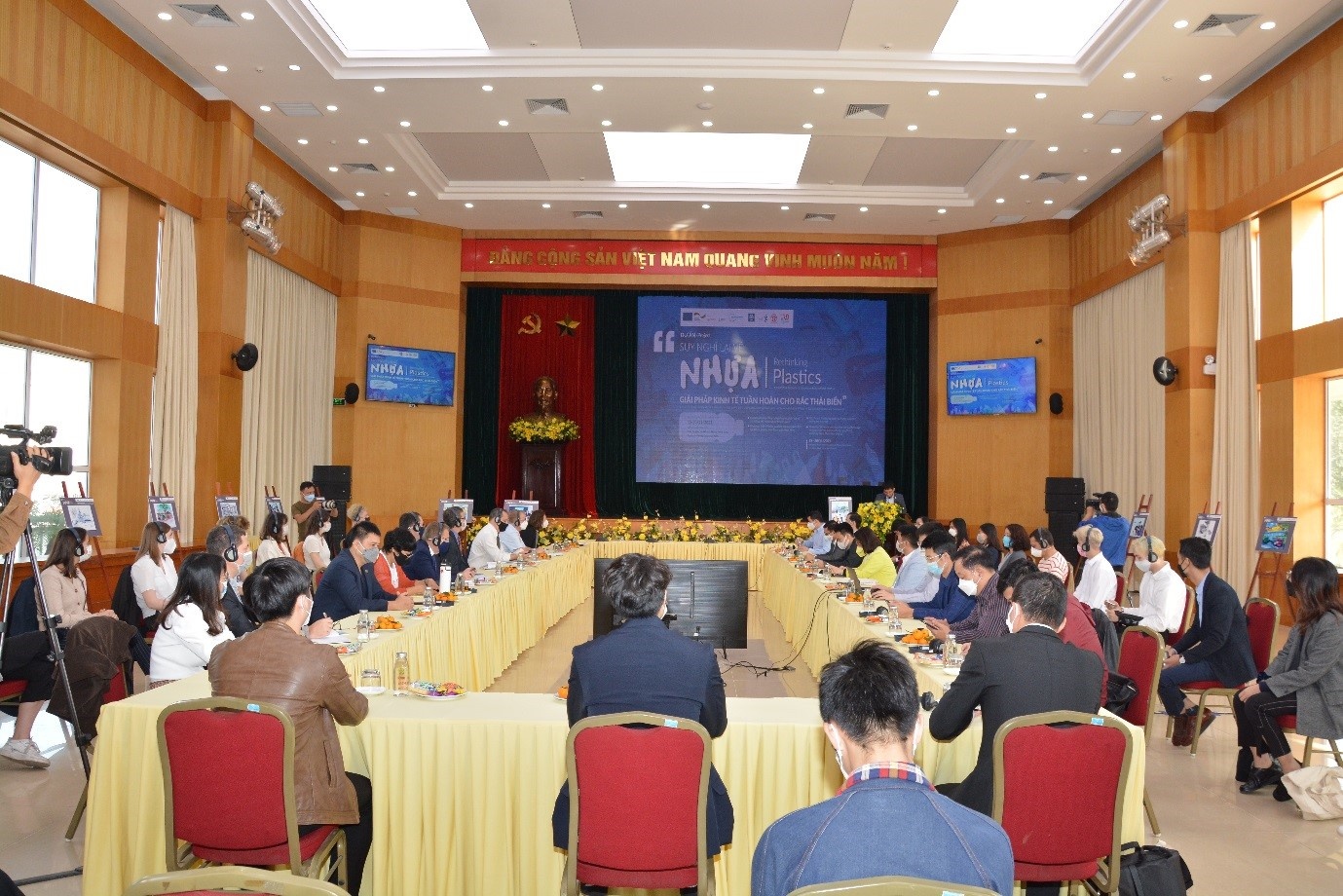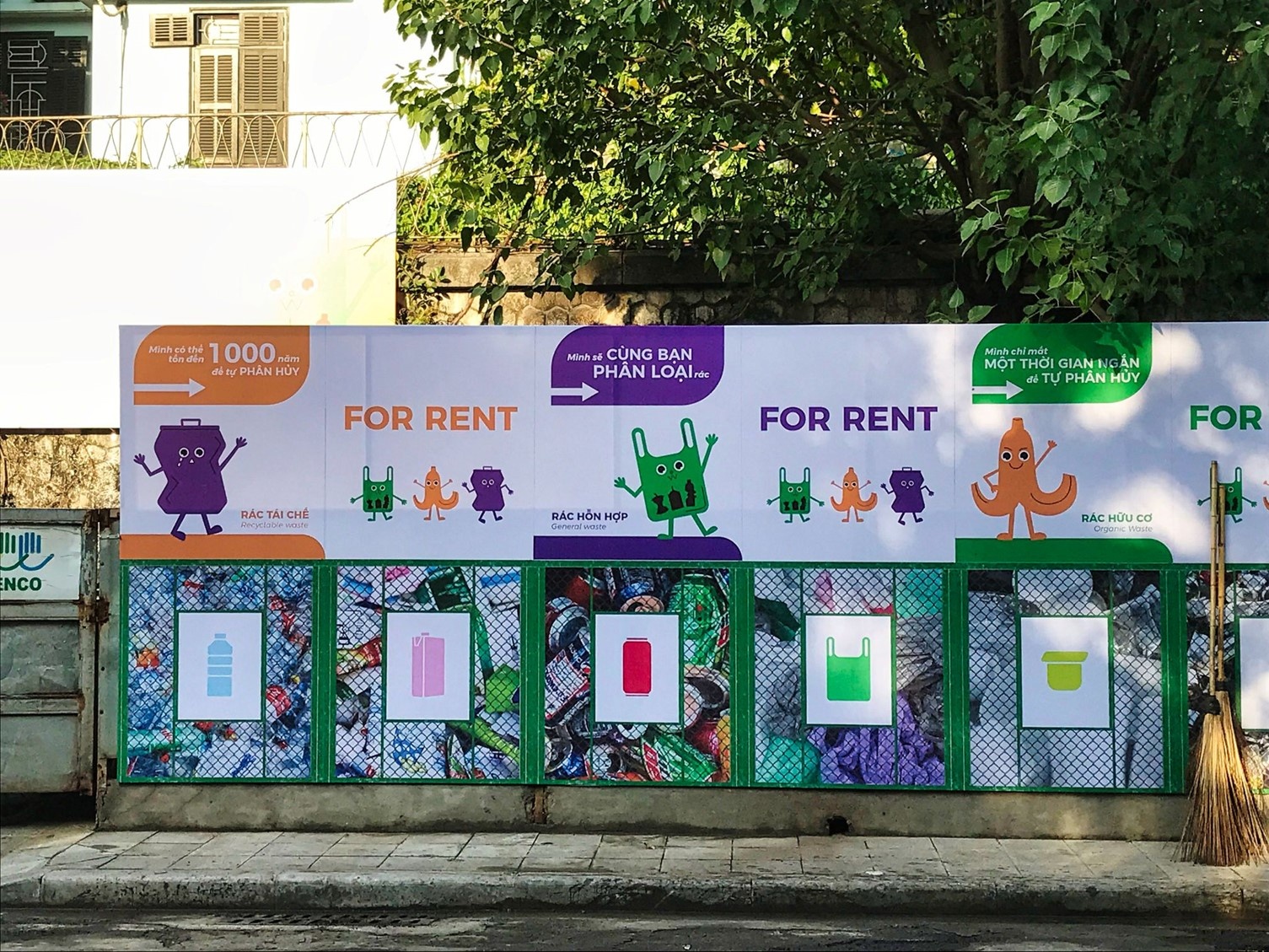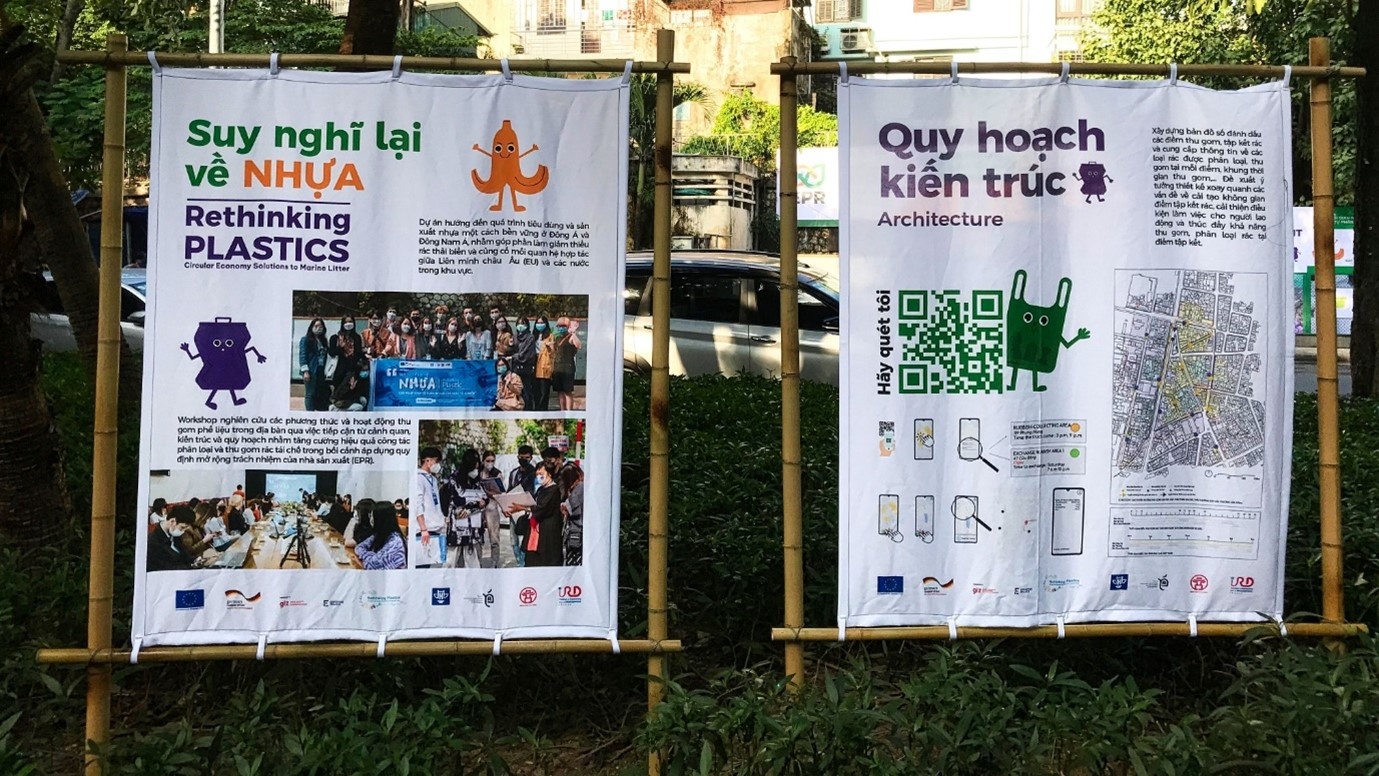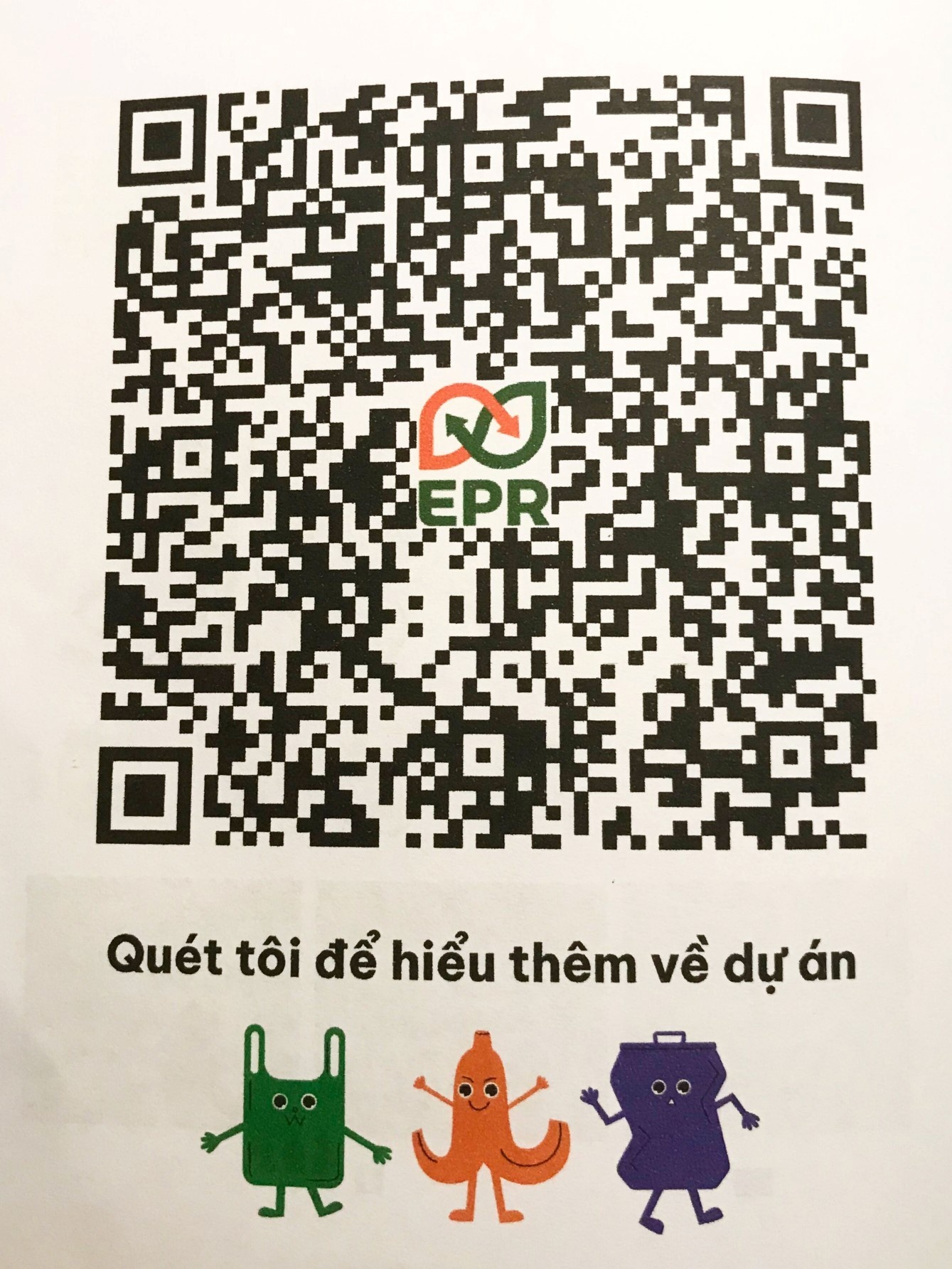Workshop highlights creativity of students regarding modern waste solutions
On 30 November, they presented their work and results at a closing ceremony, which was jointly organised by HAU and the Hoan Kiem District People’s Committee. Participants also included the Legal Affairs Department under the Ministry of Natural Resources and Environment (MONRE), Hanoi Urban Environment Co., Ltd., and other stakeholders in the chain of waste collection, classification, recycling, and treatment in Hanoi’s Cua Dong Ward.
The workshop “Designing spatial architecture and landscape of waste collection point on Phung Hung Street, Cua Dong Ward, Hoan Kiem District”, which is part of the Rethinking Plastics – Circular Economy Solutions to Marine Litter Project, aimed at concretising ideas to improve garbage classification and collection in the area, thereby promoting effective implementation of the expanded producer responsibility (EPR) principle that is part of the Law on Environmental Protection, effective from 2022.
 |
| The concluding workshop was held at the halls of Hoan Kiem People’s Committee |
The two-weeks project aimed to promote public awareness about waste collection, its classification, and recycling. The Vietnamese and French students first carried out surveys under the guidance of their lecturers. They observed for example scavenging junk collectors and the waste collection staff to get insights into the real situation of the waste collection.
The students – who came from different majors, such as graphic design, interior design, and architecture – then developed ideas and created colourful and vibrant waste collection points, infographics, posters, and other media with clear messages and detailed information on the collection and recycling of waste, as well as on the topic of EPR.
Although they only had 15 days, the students came up with modern, easy-to-understand designs which they excitedly presented at the closing ceremony. The best solutions, such as the design of a garbage collection point, will now be kept at Phung Hung street in Hoan Kiem district.
Bachelor student Nguyen Hai Anh, who majors in architecture said, “The workshop helped us understand the application of waste collection systems to raise awareness for people’s responsibility for the environment.”
The joint work also allowed the students of HAU to exchange and learn with international students. French exchange student Sarah Leroux from ENSA said, “This was my first time participating in a workshop of this scale, and we could create and realise meaningful ideas.”
 |
| Amid the project, the students designed waste collection and sorting points that work with easy-to-understand graphics to motivate people to sort their waste |
Rui Ludovino, first counsellor of Climate Action, Environment, Employment, and Social Policies at the Delegation of the EU to Vietnam said, “I highly appreciate the students’ creativity. Their logos for sorting garbage are modern, eye-catching, and friendly. The results will contribute to improving the people’s awareness in sorting garbage, thereby making the environment and landscape cleaner and more beautiful.”
 |
| The team of students also designed infographics that spread awareness for the Rethinking Plastics project and EPR, while offering simple information on waste collection and recycling such as pick-up schedules |
The workshop is part of the pilot project “Enhancing plastic packaging collection, sorting and recycling”, which is implemented by the Institut de Recherche pour le Développement and HAU, under the Rethinking Plastics project. The pilot aims to increase the collection, sorting, and recycling of plastic waste to reduce environmental leakage.
It for example aims to educate residents, local authorities, collectors, students, and lecturers at schools and universities to raise awareness for better waste management. The activity supports the ongoing activities of the Vietnamese government to set up an EPR scheme that holds companies responsible to take care of the packaging plastic waste, which is generated through the products that they sell.
The concept of EPR aims to reduce the waste that is generated by improving, for example, waste recycling. Its success depends on the population, as segregating waste is essential to obtain the quality of waste needed to recycle it. The EPR principle is part of the Law on Environmental Protection, effective from 2022 on.
Fanny Quertamp, senior advisor for Vietnam at Expertise France said, “I think that the workshop is particularly important because EPR is a new concept. Until now, just some experts, specialists, and business organisations are aware of what it is. But for citizens, it is something complex and new. So, we need to step-by-step help them to become more aware of the concept, how they can sort waste, and how and where they can deposit it conveniently all around the city.”
“The role of Hoan Kiem district is crucial because it is a central district in Hanoi. I am impressed by the work of the students in only two weeks, their designs, and especially the developed QR code. We will now have time to see how we can share and replicate what has been done in the Hoan Kiem district. We will work with MONRE and the team of the HAU to define a methodology that can be used in other cities,” Fanny said.
 |
| The QR code, which is printed on infographics and publications, offers easy access to in-depth information about waste segregation and collection, which can be scanned with any smartphone |
The pilot project is part of the Rethinking Plastics Project, co-founded by the European Union and the German Federal Ministry for Economic Cooperation and Development and implemented by the Deutsche Gesellschaft fur Internationale Zusammenarbeit (GIZ) and Expertise France.
The Rethinking Plastics project’s aims to contribute to efforts on reducing marine litter and the proliferation of plastics through cooperation with key stakeholders in enhancing policy dialogues, managing plastic waste, and promoting sustainable and responsible consumption and production practices. It is implemented across China, Indonesia, Japan, the Philippines, Singapore, Thailand, and Vietnam with a total budget of €10 million ($11.9 million).
What the stars mean:
★ Poor ★ ★ Promising ★★★ Good ★★★★ Very good ★★★★★ Exceptional
Related Contents
Latest News
More News
- Protect what’s next: towards a future free from meningococcal group B disease (December 05, 2025 | 18:00)
- New ILO report offers policy recommendations for disability inclusion (December 04, 2025 | 15:18)
- Maternal job loss may affect children’s mental health, research shows (December 03, 2025 | 19:11)
- Women lead Vietnam’s shift to climate-resilient agriculture (December 03, 2025 | 19:10)
- Experts highlight unpaid care work as key barrier to gender equality (December 03, 2025 | 15:15)
- Opportunities and inequalities for women workers in Vietnam's garment industry (December 03, 2025 | 09:00)
- Vietjet flights carry love to devastated central region (November 28, 2025 | 11:35)
- New initiative to boost the fight against domestic violence (November 26, 2025 | 10:00)
- South Korea funds IOM relief for Vietnam’s typhoon-affected communities (November 24, 2025 | 15:33)
- AI and human-centred values set to shape the future of HR in Vietnam (November 21, 2025 | 18:04)

 Tag:
Tag:



























 Mobile Version
Mobile Version